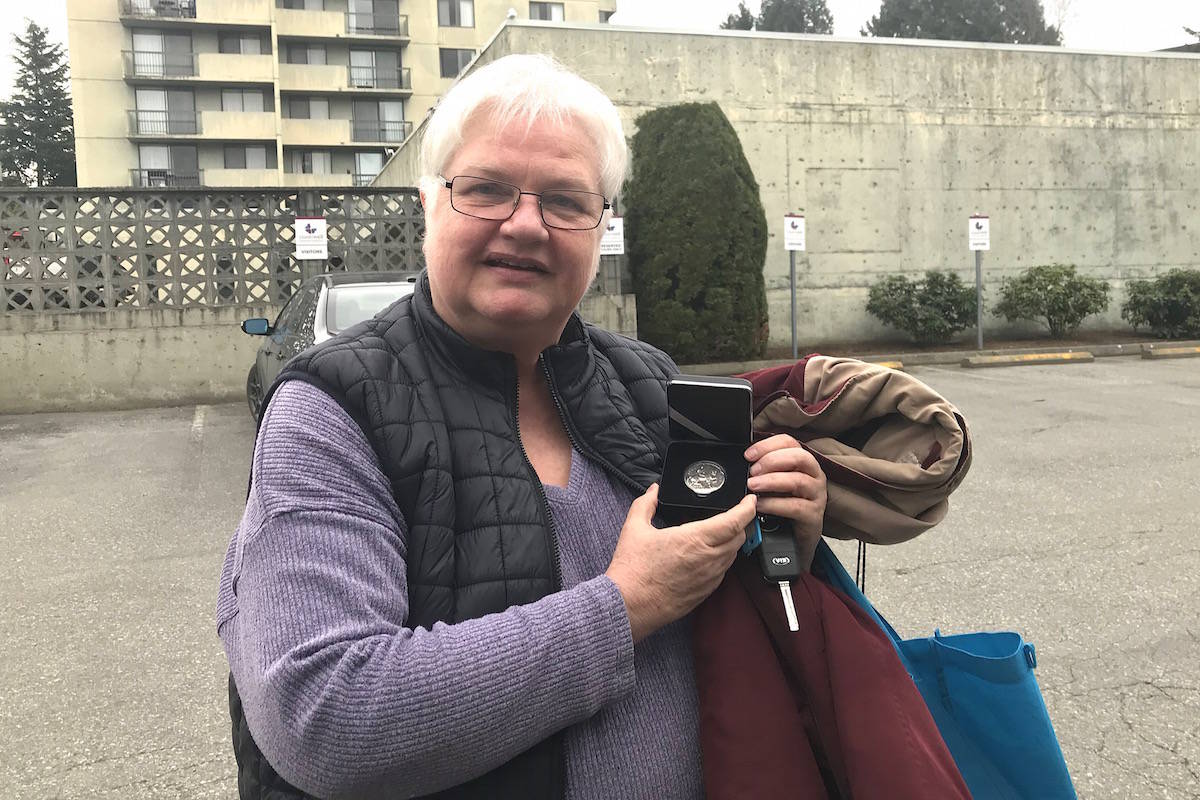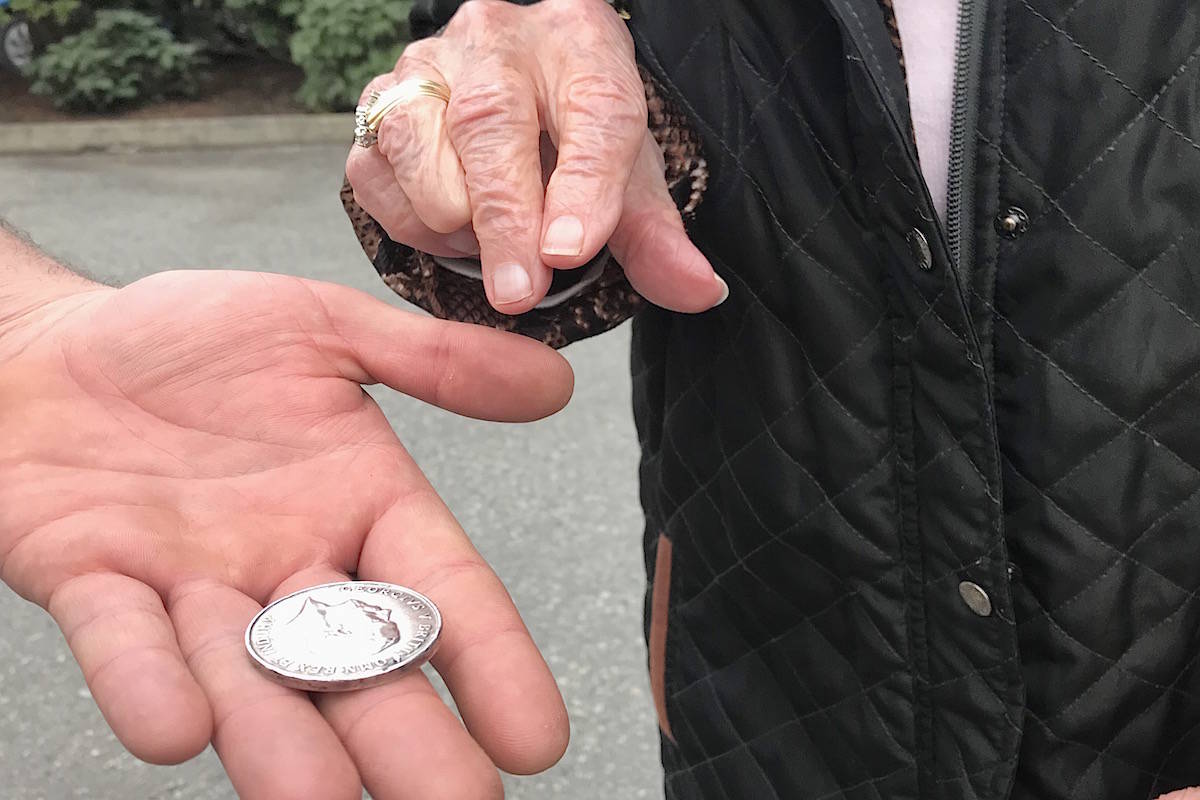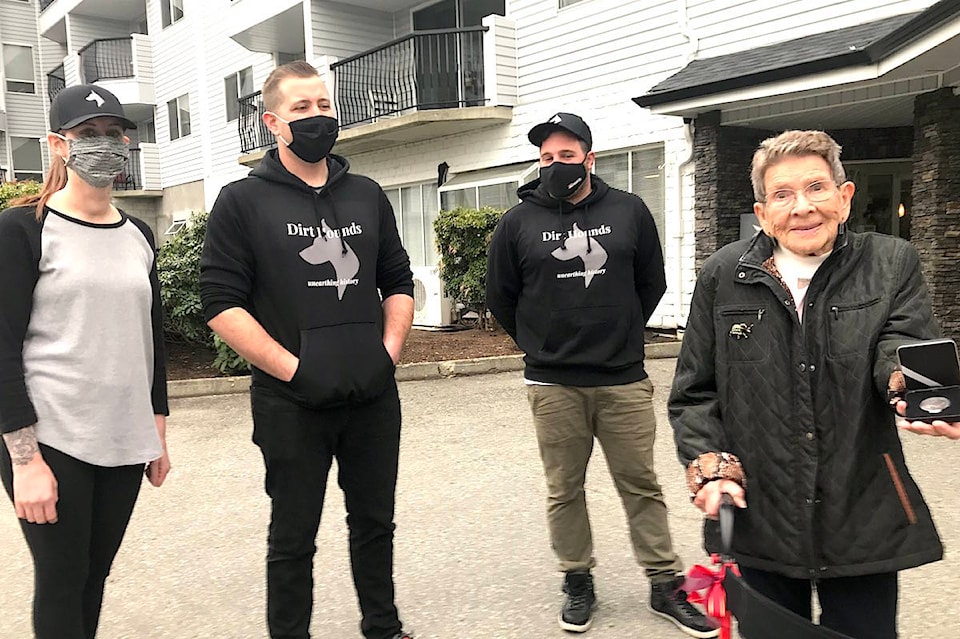The surviving Chilliwack niece of a First World War nurse was presented with a medal her aunt earned caring for soldiers more than 100 years ago.
“It’s as though I’d been chosen for something.”
Lois Maurer, 95, described how it felt to have the medal back in the hands of family in an interview outside her care home, on Sunday (March 14), with her daughter, Nada Reid.
“Because how did this come to me? Why did it get to me? I’m kind of a fatalist,” Maurer told the small crowd.
It turns out the silver medal engraved with “C. Whittle” had belonged to her aunt, Carrie Whittle.
“She must have been quite a lady,” Maurer said about the relative she never met.
Whittle had left Chilliwack by the time Maurer was born in 1925. “And my mom was too, a real hard worker and got things done.”
Handing over the medal to Maurer on Sunday was Brandon Kuczynski of Langley, who dug it out of a field in Chilliwack last spring. Together with his fiancée Bailey Andrichuk, and friend Brad Cappon of Chilliwack, they are metal-detecting hobbyists, The Dirt Hounds.
Kuczynski’s said his equipment started beeping like crazy when it detected the silver medal in the old field. It was down fairly deep. Up to that point they’d recovered coins, gold rings and cellphones in previous sessions.
Never a rare item like a nurse’s medal from the Great War like this.
“I think the museum is a great spot for it,” said Dirt Hound Brad Cappon.
It was the research of ancestry sleuth Marion Robinson, who tracked down the living relatives of C. Whittle in Chilliwack.
CTV storyteller Mike McCardell did a segment weeks ago on the Dirt Hounds trying find any living relatives of the medal recipient: C. Whittle.
Robinson said she saw the story when it aired, and got right to work on her laptop researching the Whittle family roots.
RELATED:
Kucynski said that finding the medal has put the spotlight on the life of a nurse who cared for people most of her life, which is timely during a global pandemic with the primacy of front-line healthcare workers.
The image of the wartime nurse is gradually coming into focus. Whittle was born in England in 1881, but had family who moved to Chilliwack. She eventually joined them by 1911 in a home on Camp River Road.
Caroline (Carrie) Whittle enlisted in 1914 to go overseas as a nursing volunteer and served in England and France. She was awarded the nurse’s VAD medal, Two Scarlet Efficiency Stripes, and in May 1919 was honoured with the silver British War/Victory Medal, according to Robinson’s research.
The image of King George is on one side of the medal, and a figure on horseback is on the other. The medal was a type of nurse’s honour attached by a ribbon bestowed on those who served with the Voluntary Aid Detachment (VAD) by caring for convalescing soldiers. She was posted to a hospital in Bristol, and elsewhere around London.
Her story is becoming clearer now that the medal has resurfaced.
“Caroline was a nurse dealing with trench warfare, and all the horrors that brought,” said Robinson.
She‘d also been engaged a soldier who she met overseas, but he was killed during the war.
Following the war Whittle joined a religious order, and by 1920 had became Mother Juanita Noel, and eventually founded hospitals and schools in the U.S. She worked with children suffering from polio and saved lives.
“Your auntie is truly a hero,” Robinson told Maurer. “Here we have a person who gave herself to the saving of hundreds and hundreds of people, children and adults, in the days when we didn’t have much hope for polio and neither for tuberculosis. She sets an example for us because of how she gave. And she reminds each and every one of us that we can all give, each in our own little way.”
One mystery remains, the question of how the medal ended up buried in that field in Chilliwack.
“Caroline had no kids and became a Mother Superior in Colorado. She apparently was not to have any belongings so she must have given the medal to her sister?” was one scenario Robinson was considering to explain how it got there.
Research showed that Whittle’s sister, Laura Whittle married a man named Mr. Bessette, and had kids. One of their daughters was Lois.
The family has decided to donate the medal to the Chilliwack Museum for posterity and safe-keeping, but wanted to share the extraordinary story of their family member with the public now that it has resurfaced decades after her death in 1971.
READ MORE:
Do you have something to add to this story, or something else we should report on? Email:
jfeinberg@theprogress.com
Like us on and follow us on .
Want to support local journalism during the pandemic? Make a donation






